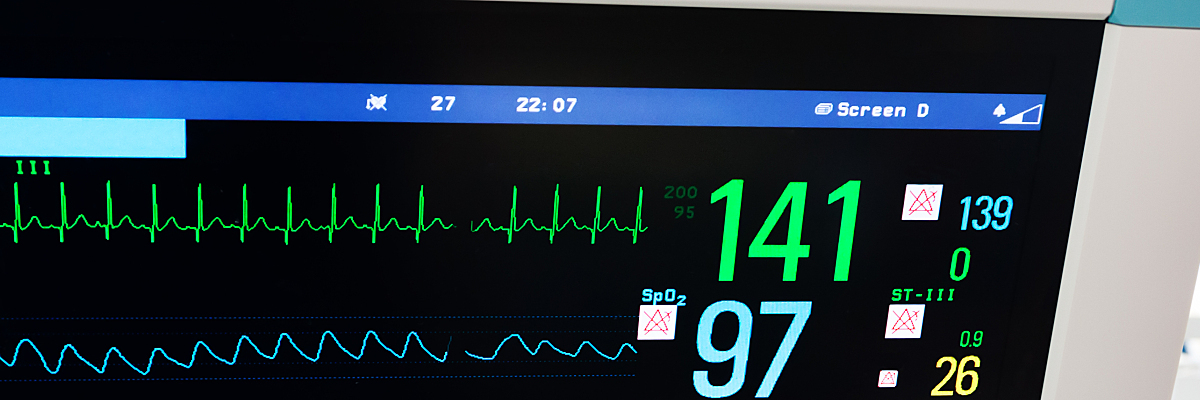Thanks to technological advances in the field of medicine, once-specialized processes are now being standardized so that any healthcare provider can learn and perform them. Neonatal resuscitation, in particular, has evolved over the years to include various tools that previously did not exist, including a warming source, pulse oximeter, and neonatal heart rate monitor. These developments have brought about significant improvements in clinical outcomes.
A major key to successful neonatal resuscitation is preparation, which includes having all necessary equipment available and in working order. The Panda Warmer ResusView*, as an example, provides all monitoring and intervention equipment needed for a full resuscitation in one portable unit, including the all-important neonatal heart rate monitor.
Neonatal heart rate monitors are often used to determine a potential need for resuscitation and to evaluate the effectiveness of any efforts performed. The monitoring—and accuracy—of this data are imperative for the health and safety of the patient.
Ways to Measure Neonatal Heart Rate
Neonatal heart rate monitoring can be accomplished manually by auscultation or palpation. Auscultation is done at the apical site whereas palpation can be done at the brachial, femoral, or umbilical site in newborns. However, both of these methods have been found to be somewhat antiquated and unreliable.
- Monitoring by palpation: A study published in the 2004 Official Journal of the European Resuscitation Council found that heart rate monitoring by palpation was unreliable, particularly by femoral or brachial assessment. In this study, pulse check via umbilical cord was only correct 55% of the time.1
- Monitoring by auscultation: A study published in the 2010 Official Journal of the European Resuscitation Council observed the time and accuracy to assess heart rate by stethoscope in a simulated environment. Time to assess the heart rate was reasonable at 7.8 to 17 seconds, but 28% would have prompted inappropriate actions and 73% resulted in overestimation of the heart rate.2
Due to the lackluster results of these methods, a new technology-based technique called pulse oximetry was recommended in 2010, with support from the American Academy of Pediatrics. This new form of monitoring oxygenation during delivery piqued interest even though there were still challenges with picking up the neonatal heart rate—challenges primarily regarding delays in obtaining accurate readings. The field was ready for something better.
The New Gold Standard
A 2012 study published in Pediatrics International examined the time it took to pick up the heart rate in infants connected to pulse oximetry compared to a neonatal heart rate monitor. They found that the heart rate was available via heart rate monitor at a median time of 38 seconds versus pulse oximetry at a median time of 122 seconds.3
Therefore, in 2015, the Neonatal Resuscitation Program (NRP) recommended the use of a neonatal heart rate monitor, a form of ECG, in the delivery room. The guidelines make this statement: "During resuscitation of term and preterm newborns, the use of 3-lead ECG for the rapid and accurate measurement of the newborn's heart rate may be reasonable."4 In the 2020 NRP guidelines, this was upgraded to the following: "During chest compressions, an ECG should be used for the rapid and accurate assessment of heart rate." The level of evidence for this finding was increased from weak to strong.
In the span of just five years, a new gold standard was born.
The ability to accurately monitor an infant's heart rate during a high-risk delivery is critical. Heart rates are used not only for assessing the effectiveness of compressions but also for ventilation and even clearance of the airway. The incidence of chest compressions is only about 1% of all deliveries, but the need for compressions cannot be accurately predicted without first knowing a heart rate.
Be Prepped and Prepared
Newborn resuscitations are stressful enough without the added stress of an uncertain heart rate assessment. Make sure all delivery staff members feel confident using a neonatal heart rate monitor. Without proper training and regular practice, navigating new tools can be difficult. While re-training in resuscitation techniques is recommended every two years, a 2019 study in Society for Simulation in Healthcare shows that performance retention can actually be much shorter than that.5
Particularly in advanced life support, including neonatal resuscitation, where coordination of effort is key, more frequent training may be indicated. A 2017 study published by the Duke University School of Medicine demonstrated that skill review may be needed as frequently as every 6 months.6 That should include training on important tools used during resuscitation protocols, such as a neonatal heart monitor.
While these monitors are not necessary for every delivery—the use of palpation or auscultation is often sufficient during an initial assessment—it is better to keep staff prepped and prepared for any and all emergent situations.
Learn more about Panda Warmer ResusView.
*Not available for sale in the United States.
References:
- Owen CJ, Wyllie JP. Determination of heart rate in the baby at birth. Resuscitation. 2004;60(2):213-7. doi: 10.1016/j.resuscitation.2003.10.002.
- Voogdt KGJA, Morrison AC, Wood FE, et al. A randomised, simulated study assessing auscultation of heart rate at birth. Resuscitation. 2010;81(8):1000-3. doi: 10.1016/j.resuscitation.2010.03.021.
- Mizumoto H, Tomotaki S, Shibata H, et al. Electrocardiogram shows reliable heart rates much earlier than pulse oximetry during neonatal resuscitation. Pediatrics International. November 2011;54(2):205-207. https://doi.org/10.1111/j.1442-200X.2011.03506.x
- Wyckoff MH, Aziz K, Escobedo MB, et al. Part 13: Neonatal resuscitation: 2015 American Heart Association guidelines update for cardiopulmonary resuscitation and emergency cardiovascular care. Pediatrics. November 2015; 136 (Supplement_2): S196–S218. https://doi.org/10.1542/peds.2015-3373G
- Saad R, Sampaio Favarato MH, Ferreira de Paiva E, et al. Medical student skill retention after cardiopulmonary resuscitation training. Simulation in Healthcare. December 2019;14(6):351-358. doi: 10.1097/SIH.0000000000000383





